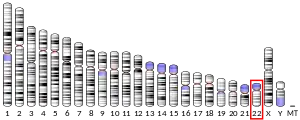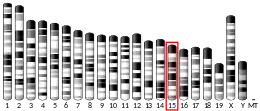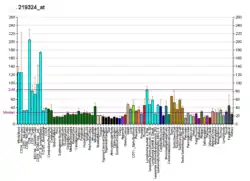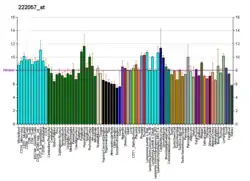| NOL12 | |||||||||||||||||||||||||||||||||||||||||||||||||||
|---|---|---|---|---|---|---|---|---|---|---|---|---|---|---|---|---|---|---|---|---|---|---|---|---|---|---|---|---|---|---|---|---|---|---|---|---|---|---|---|---|---|---|---|---|---|---|---|---|---|---|---|
| Identifiers | |||||||||||||||||||||||||||||||||||||||||||||||||||
| Aliases | NOL12, Nop25, dJ37E16.7, nucleolar protein 12 | ||||||||||||||||||||||||||||||||||||||||||||||||||
| External IDs | MGI: 2146285 HomoloGene: 32577 GeneCards: NOL12 | ||||||||||||||||||||||||||||||||||||||||||||||||||
| |||||||||||||||||||||||||||||||||||||||||||||||||||
| |||||||||||||||||||||||||||||||||||||||||||||||||||
| |||||||||||||||||||||||||||||||||||||||||||||||||||
| |||||||||||||||||||||||||||||||||||||||||||||||||||
| |||||||||||||||||||||||||||||||||||||||||||||||||||
| Wikidata | |||||||||||||||||||||||||||||||||||||||||||||||||||
| |||||||||||||||||||||||||||||||||||||||||||||||||||
Nucleolar protein 12 is a protein that in humans is encoded by the NOL12 gene.[5][6] Human NOL12 has been shown to localize in the nucleolus and regulate nucleolar structure and homeostasis by maintaining the levels of multi-functional fibrillarin and nucleolin proteins. Its deficiency leads to p53 activation resulting in G2 arrest of cell. Nol12 or hNol12 drives p53 induced cell senescence suggesting its important role in aging.[7] Human Nol12 is also required for ribosome maturation and genome integrity.[8]
Nol12 Family
Human Nol12 belongs to family of proteins known as ribosomal binding proteins RBPs. The human members have equivalents in different species. Its homologue in Drosophila melanogaster is called Viriato which is involved in eye and nervous system development and without Viriato, Drosophila melanogaster eye development fails. Loss of also Viriato resulted in cell proliferation, developmental delays and apoptosis.[9][10] hNOL12 homologue in rats is known as Nop25 and is responsible for nucleolar structure and integrity.[11] Its yeast homologue has been named as Rrp17 which has been shown to possess 5′-3′ exonuclease activity and is involved in ribosome biogenesis.[12]
References
- 1 2 3 GRCh38: Ensembl release 89: ENSG00000273899 - Ensembl, May 2017
- 1 2 3 GRCm38: Ensembl release 89: ENSMUSG00000033099 - Ensembl, May 2017
- ↑ "Human PubMed Reference:". National Center for Biotechnology Information, U.S. National Library of Medicine.
- ↑ "Mouse PubMed Reference:". National Center for Biotechnology Information, U.S. National Library of Medicine.
- ↑ Strausberg RL, Feingold EA, Grouse LH, Derge JG, Klausner RD, Collins FS, et al. (December 2002). "Generation and initial analysis of more than 15,000 full-length human and mouse cDNA sequences". Proceedings of the National Academy of Sciences of the United States of America. 99 (26): 16899–903. Bibcode:2002PNAS...9916899M. doi:10.1073/pnas.242603899. PMC 139241. PMID 12477932.
- ↑ "Entrez Gene: NOL12 nucleolar protein 12".
- ↑ Pinho M, Macedo JC, Logarinho E, Pereira PS (June 2019). "NOL12 Repression Induces Nucleolar Stress-Driven Cellular Senescence and Is Associated with Normative Aging". Molecular and Cellular Biology. 39 (12). doi:10.1128/MCB.00099-19. PMC 6549468. PMID 30988155.
- ↑ Scott DD, Trahan C, Zindy PJ, Aguilar LC, Delubac MY, Van Nostrand EL, et al. (December 2017). "Nol12 is a multifunctional RNA binding protein at the nexus of RNA and DNA metabolism". Nucleic Acids Research. 45 (21): 12509–12528. doi:10.1093/nar/gkx963. PMC 5716212. PMID 29069457.
- ↑ Marinho J, Martins T, Neto M, Casares F, Pereira PS (May 2013). "The nucleolar protein Viriato/Nol12 is required for the growth and differentiation progression activities of the Dpp pathway during Drosophila eye development". Developmental Biology. 377 (1): 154–65. doi:10.1016/j.ydbio.2013.02.003. hdl:10316/26860. PMID 23416177.
- ↑ Marinho J, Casares F, Pereira PS (January 2011). "The Drosophila Nol12 homologue viriato is a dMyc target that regulates nucleolar architecture and is required for dMyc-stimulated cell growth". Development. 138 (2): 349–57. doi:10.1242/dev.054411. hdl:10261/41278. PMID 21177347. S2CID 18287789.
- ↑ Suzuki S, Fujiwara T, Kanno M (July 2007). "Nucleolar protein Nop25 is involved in nucleolar architecture". Biochemical and Biophysical Research Communications. 358 (4): 1114–9. doi:10.1016/j.bbrc.2007.05.069. PMID 17524363.
- ↑ Oeffinger M, Zenklusen D, Ferguson A, Wei KE, El Hage A, Tollervey D, et al. (December 2009). "Rrp17p is a eukaryotic exonuclease required for 5' end processing of Pre-60S ribosomal RNA". Molecular Cell. 36 (5): 768–81. doi:10.1016/j.molcel.2009.11.011. PMC 2806520. PMID 20005841.
Further reading
- Olsen JV, Blagoev B, Gnad F, Macek B, Kumar C, Mortensen P, Mann M (November 2006). "Global, in vivo, and site-specific phosphorylation dynamics in signaling networks". Cell. 127 (3): 635–48. doi:10.1016/j.cell.2006.09.026. PMID 17081983. S2CID 7827573.
- Nousiainen M, Silljé HH, Sauer G, Nigg EA, Körner R (April 2006). "Phosphoproteome analysis of the human mitotic spindle". Proceedings of the National Academy of Sciences of the United States of America. 103 (14): 5391–6. Bibcode:2006PNAS..103.5391N. doi:10.1073/pnas.0507066103. PMC 1459365. PMID 16565220.
- Collins JE, Wright CL, Edwards CA, Davis MP, Grinham JA, Cole CG, et al. (2005). "A genome annotation-driven approach to cloning the human ORFeome". Genome Biology. 5 (10): R84. doi:10.1186/gb-2004-5-10-r84. PMC 545604. PMID 15461802.
- Collins JE, Goward ME, Cole CG, Smink LJ, Huckle EJ, Knowles S, et al. (January 2003). "Reevaluating human gene annotation: a second-generation analysis of chromosome 22". Genome Research. 13 (1): 27–36. doi:10.1101/gr.695703. PMC 430954. PMID 12529303.
- Dunham I, Shimizu N, Roe BA, Chissoe S, Hunt AR, Collins JE, et al. (December 1999). "The DNA sequence of human chromosome 22". Nature. 402 (6761): 489–95. Bibcode:1999Natur.402..489D. doi:10.1038/990031. PMID 10591208.





